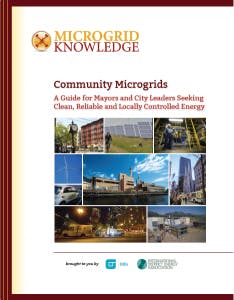When you first seek out financing for a municipal microgrid, your team should assess your organization’s credit quality, the sponsor’s capital resources, and your preferred ownership structure. Based on these considerations, your team may choose to use equity financing, debt financing, government funding, leasing, or third-party services.
Although much of the early financing for microgrids has come from government agencies, a private financing market is emerging through large companies such as Siemens and Schneider Electric. Local banks and utilities can also play a role.
Microgrid financing often must cover various components of the project, such as power and energy generation systems, energy efficiency retrofits, and distribution systems and connections. Microgrids are likely to improve their bankability if they increase their value by offering thermal energy as well as electricity.
State funding
So far, much of the funding cities and towns have tapped for microgrids comes from government sources. These may include energy bonds, tax credits, grants, loans, tax deductions, and credit enhancements from federal organizations. It is not unusual for governments to provide early funding for energy technologies that they see as promising but in need of an initial boost to create demonstration projects.
Some states also offer incentives for microgrids, or for components of the project, such as combined heat and power. In Chapter 6 we profile several of these projects.
Massachusetts in 2014 granted $18.4 million to cities and towns for energy resiliency projects, including microgrids. Connecticut has allotted $23 million to microgrid projects through two competitive solicitations, with most of the funding going to municipal projects. The New England state at this writing was planning a third round of microgrid funding. California funded $27.3 million for 10 microgrid and electric vehicle charging projects, including several that will benefit municipalities.
In addition, New Jersey has created a $200 million resilience bank for the development of distributed energy resources at critical facilities. Other states, including California, Connecticut and New York, have developed Green Banks, which use public funding to leverage private capital; the funds may cover components of microgrids, such as solar energy.
But most notable among state programs is the NY Prize, a $40 million grant program to create model community microgrids. New York has already begun awarding $100,000 prizes to cities for feasibility studies in the first stage of what will be a three-stage grant process. Money is available for local governments, community organizations, non-profit entities, for-profit companies and municipally-owned utilities. More details about NY Prize are here.
Several state incentive programs also exist that can help fund the generation portion of the microgrid, particularly combined heat & power and solar.
Other government financing
In addition, energy bonds such as qualified energy conservation bonds (QECBs), taxable bonds, and tax-exempt bonds may assist municipal microgrid developers. Agencies can issue tax-exempt bonds to access lower interest rates than banks provide.
Several federal tax credits are available for the generation portion of a microgrid. However, municipalities generally must partner with a private entity for the project to reap the tax benefits.
Federal tax benefits can be grouped into two types: investment tax credits (ITCs) and production tax credits (PTCs). ITCs cover the capital costs of renewable energy sources and cogeneration. PTCs cover large-scale wind power, biomass energy, and other renewable energy sources.
Specific federal tax credits cover qualified fuel cells, solar power, wind power, microturbines, biomass, geothermal energy, CHP, thermal pumps, marine power, hydropower, and energy from municipal solid waste. These tax credits are usually 30 percent, but some are only 10 percent. Some of these credits are no longer available, since they required construction to begin before 2014. The remaining credits will expire at the end of 2016 unless new legislation changes the picture.
Tax credits benefits do not offer any direct value to municipalities or tax-exempt organizations. However, municipalities can partner with private entities that can use the tax credits. This kind of partnership can lead to more favorable project economics.
Credit enhancements allow borrowers to ask third parties to commit to pay their debts in case of default. The third parties’ credit ratings help to lower costs for the borrowers. Credit enhancements are available from the United States Department of Agriculture, the United States Department of Energy, and other funders.
Tax deductions for cities and towns developing microgrids may include the commercial energy efficiency deduction on capital costs, accelerated depreciation on the capital cost of energy projects, and sales or property tax exemptions.
Private financing
Cities and towns can access private financing through partnerships with public benefit corporations, energy service companies, private investors, banks and utilities. Private equity firms are beginning to offer financing specifically for community microgrids.
Public benefit corporations can issue tax-exempt leases to nonprofits for energy efficiency and cogeneration equipment in some cases.
Energy service companies can own and operate microgrids for municipal customers. Customers pay these companies in the same way as they would pay utilities.
Private investors support equity financing by contributing to projects and then receiving shares of the returns. There are two methods of using shared savings to finance microgrids. In one approach, the developer provides the capital and shares more of the savings. In a second approach, the sponsor plays that role.
Banks provide debt financing with the expectation of being repaid through principal and interest payments. Credit ratings and credit enhancements determine the interest that the debt financiers assess.
Many utilities offer incentive programs that provide rebates and rewards to cities and towns.
Conclusion
As you draw up the blueprint for financing a municipal microgrid, consider the factors outlined above. Bring together a knowledgeable team of stakeholders with experience in microgrid financing. Evaluate the many sources of capital that can be used to support the physical components of your project. As you map out your options, inquire about each funding source to see what opportunities will work best for your town or city. Your job can be made easier by working with an experienced energy development team—particularly one knowledgeable about microgrids, CHP and district energy.
So far we’ve provided a basic overview of the microgrid and its components. And we’ve discussed microgrid benefits and how communities can pay for projects. Now we will look at next steps to develop a microgrid, and how mayors and city leaders can this technology to their communities.
Special thanks to Kat Friedrich for her many contributions to this article.
To read the rest of this article series now, go to “Community Microgrids: A Guide for Mayors and City Leaders Seeking Clean, Reliable and Locally Controlled Energy,” available as a free download, courtesy of the International District Energy Association (IDEA) and OBG. Or visit MicrogridKnowledge.com next week.
Note: This is the fifth article in our series on community microgrids. See our first three articles:








